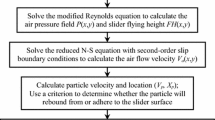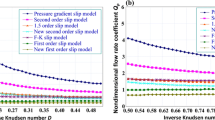Abstract
An entrapped particle on the slider air bearings damages the surface of the slider or the disk. The study of particle movement on and the particle adhesion mechanism onto the slider surface is critical to reduce entrapped particle-induced damage. This paper investigates the interaction between the particles and slider surface. The particle trajectories in the far-field region are calculated using the classical Runge–Kutta method. In the near-field region, where the distance between the particle and slider surface is less than the mesh size, a new model was applied to predict the particle trajectory and whether the particle will be captured or rebound from the slider surface after the collision. A rebound model was employed to calculate the particle rebound velocity and its corresponding rebound trajectory. It was found that the particle critical velocity for rebound increases as the particle size decreases. The velocity ratio decreases as the incident velocity decreases for the same particle diameter, and it is sensitive to the particle size at a low incident velocity. For the particle collides with and rebounds from the slider surface, the negative rebound velocity makes the particles bounce a small distance away from the pad surface. The force acting on the particles also changes from negative to positive values, and they possibly undergo secondary impacts on the slider surface following air flow, which further lower the particles’ velocity and increases the possibility of particles adhere to the slider surface.






Similar content being viewed by others
References
Barnocky G, Davis RH (1988) The effect of Maxwell slip on the aerodynamic collision and rebound of spherical particle. J Colloid Interface Sci 121:226–239
Bateman AP, Belassein H, Martin ST (2014) Impactor apparatus for the study of particle rebound: relative humidity and capillary forces. Aerosol Sci Technol 48:42–52
Chung KH, Oh JK, Moon JT, Kim DE (2004) Particle monitoring method using acoustic emission signal for analysis of slider/disk/particle interaction. Tribol Int 37:849–857
Dahneke B (1971) The capture of aerosol particles by surface. J Colloid Interface Sci 37:342–353
Dahneke B (1972) The influence of flattening on the adhesion of particles. J Colloid Interface Sci 40:1–13
Dahneke B (1973) Measurements of bouncing of small latex particles. J Colloid Interface Sci 45:584–590
Dahneke B (1975) Further measurements of the bouncing of small latex spheres. J Colloid Interface Sci 51:58–65
Esmen NA, Ziegler P, Whitfield R (1978) The adhesion of particles upon impaction. J Aerosol Sci 9:547–556
Hamaker HC (1937) The London-Van Der Waals attraction between spherical particles. Physica 4:1058
Israelachvili JN (2011) Intermolecular and surface forces: revised third edition. Academic press, London
Liu N, Bogy DB (2003) Particle contamination on a thermal flying-height control slider. Tribol Lett 37:93–97
Liu N, Bogy DB (2009) Boundary effect on particle motion in the head disk interface. Tribol Lett 33:21–27
Liu S, Li H, Shen S, Wu S (2015a) Simulation of particle trajectory in the head-disk interface. IEEE Trans Magn 51:1–4
Liu S, Li H, Shen S, Wu S (2015b) Simulation of the interaction between particle and slider surface. In 2015 JSME-IIP/ASME-ISPS joint conference on micromechatronics for information and precision equipment (MIPE2015), 14/6/2015–17/6/2015, p MoP-05
Park HS, Hwang J, Choa SH (2000) Investigation of contamination particle’s trajectory in a slider disk interface. IEEE Trans Magn 36:2739–2741
Rogers LN, Reed J (1984) The adhesion of particles undergoing an elastic plastic impact with a surface. J Phys D Appl Phys 17:677–689
Shen X, Bogy DB (2003) Particle flow and contamination in slider air bearings for hard disk drives. J Tribol 125:358–363
Shen X, Bogy DB (2008) Contact force and frictional heating due to “large” particles in the head disk interface. J Tribol 130:011015
Wahl MH, Lee PR, Talke FE (1996) An efficient finite element-based air bearing simulator for pivoted slider bearings using bi-conjugate gradient algorithms. Tribol Trans 39:130–138
Wall S, John W, Wang HC, Goren SL (1990) Measurements of kinetic energy loss for particles impacting surfaces. Aerosol Sci Technol 12:926–946
Xu J, Tokisue H, Tanaka H, Matsumoto M (2003) In-situ studies of contamination at hard-disk interface. Microsyst Technol 9:250–255
Zeng Q, Pit R, Payne R, Baumgart P, Huang FY (2005) Modeling and simulation of hard-particle interaction in head/disk interfaces. IEEE Trans Magn 41:604–609
Zhang S, Bogy DB (1997) Effects of lift on the motion of particles in the recessed regions of a slider. Phys Fluids 9:1265–1272
Zhang B, Nakajima A (2003) Possibility of surface force effect in slider air bearings of 100 Gbit/in 2 hard disks. Tribol Int 36:291–296
Zhang S, Strom BD (2008) Predicting air bearing contamination using air flow pattern analysis. J Tribol 130:011002
Zhou W, Liu B, Yu S, Hua W, Gonzaga L (2010) Effects of gas physical properties on flying performance of air bearing slider. IEEE Trans Magn 46(6):1389–1392
Acknowledgments
This work was supported by National Natural Science Foundation of China (Grant No. 51505342) and Fundamental Research Funds for the Central Universities of China (Grant No. 2042015kf0193). Authors gratefully acknowledge these supports.
Author information
Authors and Affiliations
Corresponding author
Rights and permissions
About this article
Cite this article
Liu, S., Li, H., Shen, S. et al. Simulation of particle rebounding from the slider air bearing surface. Microsyst Technol 22, 1475–1481 (2016). https://doi.org/10.1007/s00542-016-2847-x
Received:
Accepted:
Published:
Issue Date:
DOI: https://doi.org/10.1007/s00542-016-2847-x




